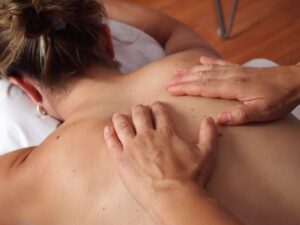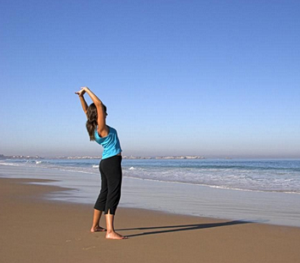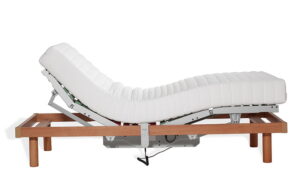What is Degenerative Disc Disease?

Degenerative disc disease is a common condition that affects the spine, causing pain and discomfort. It occurs when the discs between the vertebrae in the spine become worn down and no longer provide adequate cushioning and support.
Symptoms include pain in the lower back, neck, and other areas of the body, as well as stiffness, numbness, and tingling. Treatment options may include physical therapy, medications, and surgery.
In addition, making lifestyle changes and taking preventive measures can help reduce the risk of developing degenerative disc disease. This article will provide an overview of the causes, symptoms, treatments, and prevention of degenerative disc disease.
What Happens to Your Spine When You Have Degenerative Disc Disease?
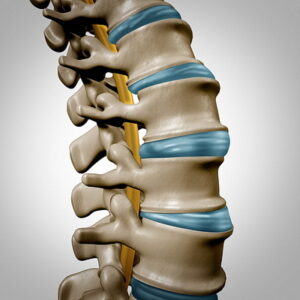
As mentioned, degenerative disc disease is a condition that involves the breakdown of the substances found within the vertebrae, which are called the discs.
The discs (blue areas in the picture) act as cushions and are made of a jelly-like substance called the intervertebral disc. There are 24 of them in the spine and over time, they can deform, especially when under a lot of pressure, causing them to become thinner and more brittle. When this happens the gel will leak out and the disc will press against the surrounding nerves, consequently sending pain signals to the brain.
What are the Symptoms?
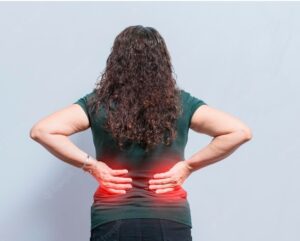
The symptoms can vary, depending on the location of the decay. In the lower back, you may feel pain, stiffness, and difficulty standing up, especially after sitting for an extended period.
If the discomfort occurs in the lumbar region of the back, you may also feel pressure or numbness in your legs. If the degeneration occurs in the cervical region of the spine, it may cause pain in the neck and upper back, as well as tingling or numbness in the arms.
Causes of Degenerative Disc Disease
Seniors might not like hearing this but it is a natural part of the aging process. However, a decline of the discs can also occur in younger people who are involved in frequent or heavy lifting, poor posture, or inadequate core strength.
As people age, their discs can break down and the cartilage that cushions the spine begins to wear. Below is a list of possible reasons why you may encounter disc degeneration:
-
-
- Age: As mentioned, your spine may encounter disc degeneration as you get older.
- Poor posture: When a person constantly slouches, they are putting more pressure on their spine, which can cause the discs to break down faster.
- Excessive lifting: If you frequently lift heavy objects, you increase your risk of putting too much pressure on your spine and increasing the risk of disc breakdown.
- Genetic factors: Some people are more likely to develop degenerative disc disease than others.
-
Diagnosis
Most doctors will diagnose this disc breakdown based on your symptoms. They may order imaging tests, such as X-rays or MRIs, to rule out other conditions and to see the extent of the degeneration. MRIs are more effective at detecting degeneration than X-rays.
Treatments
Treatments will depend on the severity of your symptoms and the location of the degeneration. If you have mild degenerative disc disease, your doctor may recommend lifestyle changes, such as increasing changing your posture and avoiding heavy lifting.
Try These Pain-Reducing Options First
-
-
- Exercise: There are numerous exercises you can do that are specifically catered to back pain
Weight Loss: Losing weight reduces the pressure on your disks when you are lying down - New Mattress: Many people, as well as experts state that a new mattress may be helpful, especially if your mattress is old. But you have to get the correct one. Getting a mattress where your feet can be raised can also benefit you. Speak to your doctor. Get the information you need about a good mattress, then go to a mattress store and tell them what you need.
- Pain Management: These medical professionals specialize in managing pain. Most likely, they will suggest physical therapy.
- Exercise: There are numerous exercises you can do that are specifically catered to back pain
-
If your symptoms are moderate to severe, your physician may recommend non-surgical treatments, such as physical therapy, chiropractic care, or possibly acupuncture. If your symptoms are severe and you don’t respond positively to non-surgical treatments, your doctor may recommend surgery.
Surgery
Although the decay of the spine’s discs is a natural part of the aging process, it can lead to severe pain and discomfort in some people, and in some cases, surgery may be necessary to fuse two or more vertebrae in the spine and prevent them from rubbing against each other.
The surgery is known as a spinal fusion, and it is often recommended for people as a last resort if the other treatments have failed to respond adequately. The surgery may be recommended for people who have severe degenerative disc disease in the lumbar region of the spine, have a herniated disc in the lumbar region, or have a degenerative disc disease that causes instability in the cervical region.
Depending on the location of the degeneration, the surgery will vary. For example, lumbar degenerative disc disease will usually be treated with lumbar spinal fusion. Cervical degenerative disc disease will usually be treated with cervical spinal fusion.
Lifestyle Changes Can Help Reduce the Risk of Degenerative Disc Disease

As mentioned above, certain lifestyle changes can help reduce the risk of developing decaying discs. It is important to note that no one knows exactly what causes the disease, so it can be difficult to prevent. However, there are some things you can do to help protect your spine, including:
-
-
- Maintaining a healthy weight: Being overweight can put extra pressure on your spine and increase your risk of developing degenerative disc disease.
- Practicing good posture: Maintaining good posture can reduce the stress on your spine by as much as 80%, which can help prevent the discs from breaking down.
- Engaging in core-strengthening exercises: Exercises such as Pilates, yoga, and lifting weights can help strengthen the core muscles, which can reduce the risk of back pain.
- Avoid heavy lifting: If you don’t have to lift heavy objects, try to find ways to get around them.
-
Preventive Measures
You can take preventive measures to reduce your risk of degenerative disc disease by engaging in regular exercise, maintaining a healthy weight, and practicing good posture.
If you have a family history of degenerative disc disease, you may want to have your doctor perform an MRI to see if you have any signs of it in your discs. If you do, you can work with your doctor to develop a treatment plan to help prevent the degeneration from getting worse.



